Health Ministry: There Are a Few COVID Positive Tourists in Pula and Zadar
ZAGREB, July 2, 2020 - The Health Ministry's State Secretary Tomislav Dulibic informed the government on Thursday that there were a few cases of tourists diagnosed with COVID-19 in Pula and Zadar, and that they had been provided with epidemiological treatment, which was why there was no further spread of the virus.
"When it comes to tourists, there are a few cases of (coronavirus) infections in Pula and Zadar, they have been treated epidemiologically, and this is a negligible number taking into consideration the total number of visitors," Dulibic said.
In Croatia, in the past 24 hours, 81 out of 981 tests performed for COVID-19 have returned positive. Also, there have been two deaths in connection with the infection.
The active hotspots of the infection are the eastern town of Djakovo where the infection was imported from Kosovo and Zagreb where 48 newly infected persons have been in connection with the infection in night clubs.
81 New COVID Cases, Two More Coronavirus-Related Deaths in Croatia
ZAGREB, July 2, 2020 - In the last 24 hours, there have been 81 new patients diagnosed with COVID-19 and two more COVID-elated deaths in Croatia, the COVID-19 crisis response team stated on Thursday afternoon.
Currently, the number of active COVID-19 cases stands at 647, and of them, 84 are being treated in hospitals, including three patients placed on ventilators.
Since February 25, when the first case was recorded in Croatia, there have been 2,912 cases of infection.
To date, 110 people diagnosed with COVID have died and 2,155 have recovered.
A total of 81,437 people have been tested, including 981 in the last 24 hours.
The data presented in the team's press release were collected until 1245 hours Thursday.
Croatia Records 67 New Coronavirus Cases
ZAGREB, June 28, 2020 - Over the past 24 hours, 67 new coronavirus infections have been recorded in Croatia, putting the number of active cases at 435, the national COVID-19 crisis management team said on Sunday.
Of the 435 active cases, 60 are hospitalised but not one patient is on a ventilator.
Since February 25, when the first case was recorded in Croatia, 2,691 persons have been infected with the novel coronavirus, 107 of whom have died, while 2,152 have recovered.
Currently, 2,279 persons are self-isolating.
To date, 77,453 persons have been tested, including 829 over the past 24 hours.
Split Restaurant Zrno Soli First in Croatia to Receive Adriacert COVID-19 Safe Certificate
June 27, 2020 - Split Restaurant Zrno Soli is the first restaurant in Croatia to be certified COVID-19 safe by Adriacert.
Dalmacija Danas reports that leading auditors of TÜV adria and Adriacert, i.e., project leaders Ph.D. Damir Ježek and quality control Joško Bekavac and other associates of the Exquisite Quality platform, on behalf of Adriacert, awarded the SARS-CoV-2 certificate of technical safety measures to restaurant Zrno Soli in Split. This certificate confirms that Zrno Soli operates in accordance with the highest standards and guidelines following legal health care measures and the Act on the protection of the population from infectious diseases and related ordinances, decisions, instructions and recommendations of the Croatian Institute of Public Health and other competent bodies and institutions.
A detailed independent review established that all measures were taken for safe operation during the COVID-19 pandemic, and their strict adherence was ensured, with emphasis on the adoption and implementation of best practices and standards, while maintaining quality communication with restaurant guests.
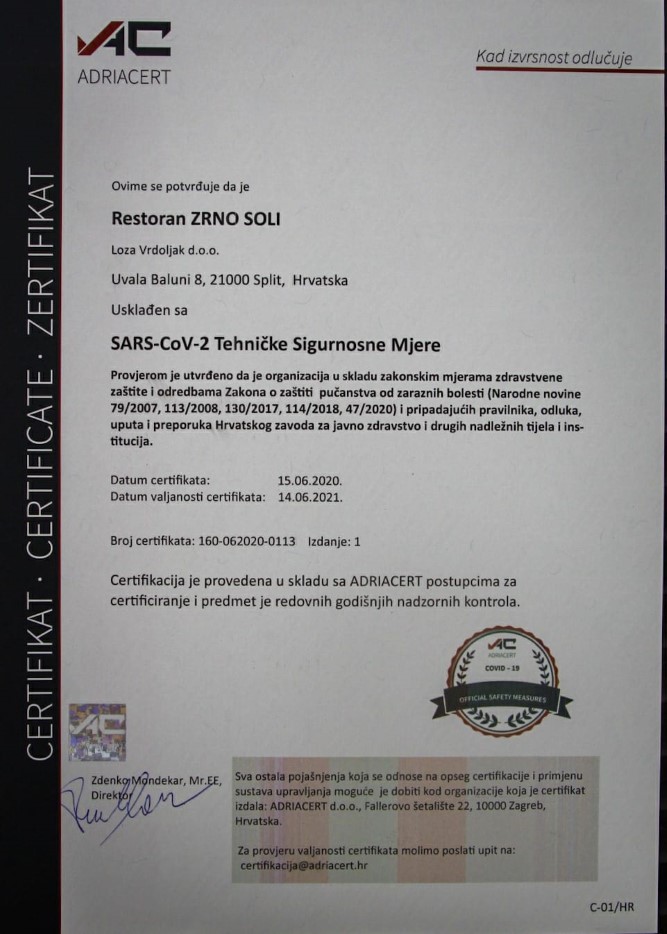
All restaurant guests must disinfect their shoes at the entrance with a special mat and should disinfect their hands. In addition, there are mini disinfectants on the tables that the guest uses during their visit to the restaurant, and can take them with them, too. The restaurant is cleaned and disinfected several times during the day, both in the hall and in the kitchen. In addition to cleaning and disinfection, spacing was implemented between the tables, according to the recommendations of the Civil Protection Headquarters, and the tablecloths are changed after the departure of each guest, as is the practice already.
The obtained certificate is further proof that Zrno Soli prioritizes its guests, their well-being, protection and safety.
Adriacert Ltd. is an international certification body that covers Slovenia, Croatia, Bosnia and Herzegovina, Serbia, Macedonia, Kosovo and Montenegro, giving top-level professional certification services to raise business capability.
To read more about lifestyle in Croatia, follow TCN's dedicated page.
Croatia Reports 56 New Cases of COVID-19
ZAGREB, June 26, 2020 - Croatia has confirmed 56 new cases of the coronavirus and currently, the total number of people infected since the outbreak stands at 2,539, the national COVID-19 response team said on Friday.
"Fifty-six new cases have been identified in the past 24 hours, which means that 2,539 people have been infected with the coronavirus," deputy director of the Croatian Institute for Public Health (HZJZ) Marija Bubas told a press conference.
There are 23 new cases in Zagreb, 12 in Osijek-Baranja County, 5 each in Primorje-Gorski Kotar, Split-Dalmatia, and Zagreb counties, 2 each in Zadar and Koprivnica-Krizevci counties and 1 each in Brod-Posavina and Varazdin counties.
A total of 75,437 sample tests have been taken, including 780 in the past 24 hours. 51 patients are being treated in hospitals however there aren't any patients connected to ventilators.
To date, 2,150 people have recovered from the virus while the death toll stands at 107.
Beros: Indirect Indicators Show Virus Has Mutated
ZAGREB, June 24, 2020 - Health Minister Vili Beros said in Split on Wednesday that 92% of the newly infected people with COVID-19 are younger than 60 and that they do not have clinical symptoms, which is an indirect indicator that the virus has mutated.
"I read a scientific article about that but we won't speculate as the virus is with us and we are aware that we have to be responsible and cautious," Beros said.
Responding to questions from reporters, Beros said that all tourists who fall ill would be taken care of in health institutions, while those not exhibiting symptoms would need to self-isolate. That is why it has been suggested that quarantine areas be set up to accommodate such tourists, he added.
"Given that most of them will be in good condition, bilateral talks are being held with countries tourists are coming from to arrange their repatriation. I don't think that any country will prevent the return of its own citizens as long as they are ordered to self-isolate. We are also developing additional capacities for testing everyone in order to remove any doubt of them being positive or not," Beros said.
Reporters were interested whether any charges would be laid in the wake of the Adria Tour tennis tournament in Zadar where the first case was registered on Sunday when Bulgarian tennis player Grigor Dimitrov admitted that he was infected with the novel coronavirus.
Beros said that repressive measures were not in his remit but that he appeals to all organisers of similar events to ensure consistent observance of physical distancing, hygiene, and other recommendations.
Beros confirmed that no new cases had been registered in Split-Dalmatia or Istria counties and that there were fewer new cases in Croatia today than yesterday.
PM: Government Has Shown "The Strength of the State" During the Crisis
ZAGREB, June 12, 2020 - Prime Minister Andrej Plenkovic on Friday praised his government for all it had done to contain the spread of the coronavirus pandemic, stressing that it had stood by the workers and employers and shown "the strength of the state" during the crisis.
"In this corona crisis you could see how our government managed to quickly and effectively prevent this epidemic from spreading in Croatia while at the same time standing, like no government before it, by the workers, employers and all those who would probably have ended up on the dole had it not been for our measures, and the employers would hardly have overcome the crisis," the prime minister said at a gathering of members of the Vukovar branch of his Croatian Democratic Union (HDZ) party.
He said that the government had shown "the strength of the state" during the crisis. "We showed how to protect and secure public health and how to preserve jobs," he said, adding that all this was possible because over the past four years the government had been working on promoting healthy economic growth, which has been recognised outside Croatia as well.
"Our investment credit rating has been maintained. Yesterday's €2 billion bond issue, when investors were interested in nearly €9 billion at much more favour interest rates and when we managed to save HRK 360 million annually compared to the same such instrument from 2010, means that there is trust in this government," Plenkovic said.
Decline In New Car Demand In Croatia Deeper Than EU Average
ZAGREB, May 24, 2020 - The EU new car demand sank in April due to measures for suppressing the coronavirus pandemic, and the decline in Croatia was higher than the EU average, it was reported earlier this week by the European Automobile Manufacturers' Association (ACEA).
In April 2020, 270,682 new cars in total were registered in the 26 EU member states (without Malta, for which data was unavailable), which is a year-on-year decline of 76.3%.
April was the first full month with Covid-19 measures in place from the first to the last day, the ACEA underscores in its explanation of the largest drop in demand since it started publishing reports.
Among the leading EU markets, demand sank the most in Italy (-97.6%) and Spain (-96.5%). The pandemic affected these two European countries the most.
In Germany, the demand dropped by 61.1%, while it sank by 88.8% in France.
According to the ACEA data, 1,077 new vehicles were registered in Croatia in April 2020, down by 87.5% compared to April 2019. In March, the demand for cars dropped by 46.2%.
The sharp decline in the first four months of 2020
In the period from January to April 2020, the EU demand for new passenger cars contracted by 38.5% owing to the pandemic, the ACEA reports.
In the first four months of 2020, 11,078 new cars in total were registered in Croatia, which is a decrease of 46.8% compared to the same period in 2019, the ACEA report shows.
Where Will Croats Go After the Measures are Eased?
May 10, 2020 - While we were patiently waiting for the measures to be eased, we asked Croats about their plans on the first day with a bit more freedom.
After almost two months of strict measures that limited our freedom of leaving our homes or the county, today there was a decision to eliminate e-passes, except for Brač, where, according to the decision, there is still ban on movement and gathering. Thus, on Brač, the measures from before April 27 are applied. Here is the link about the situation on Brač.
We asked Croats how they are planning to spend the very first day with new, eased measures and gathered 311 responses.
The first statement was, "I'll go to the cafe for coffee," and surprisingly, for a nation who loves enjoying the sun on the terrace while drinking coffee with friends, just 52,2% said yes.
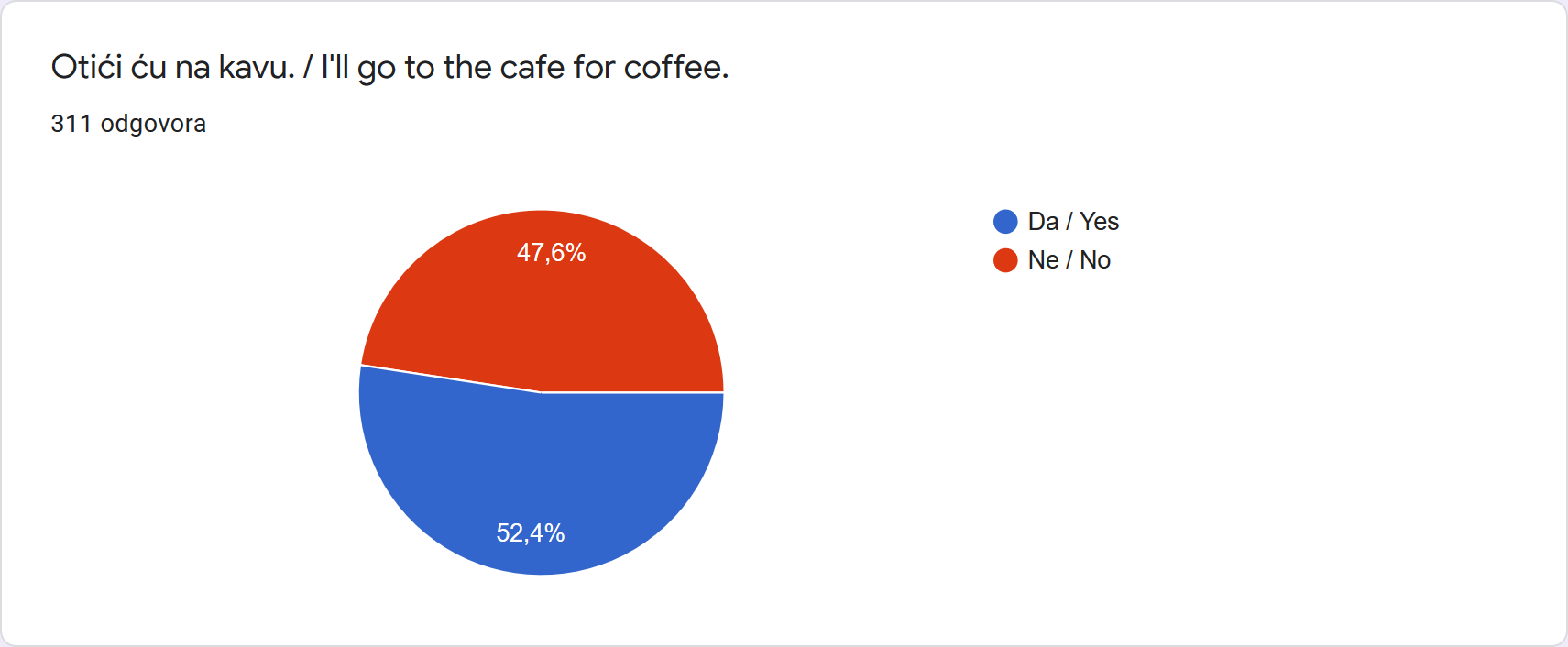
They are even less ready to leave their county, with a total of 55% negative answers.
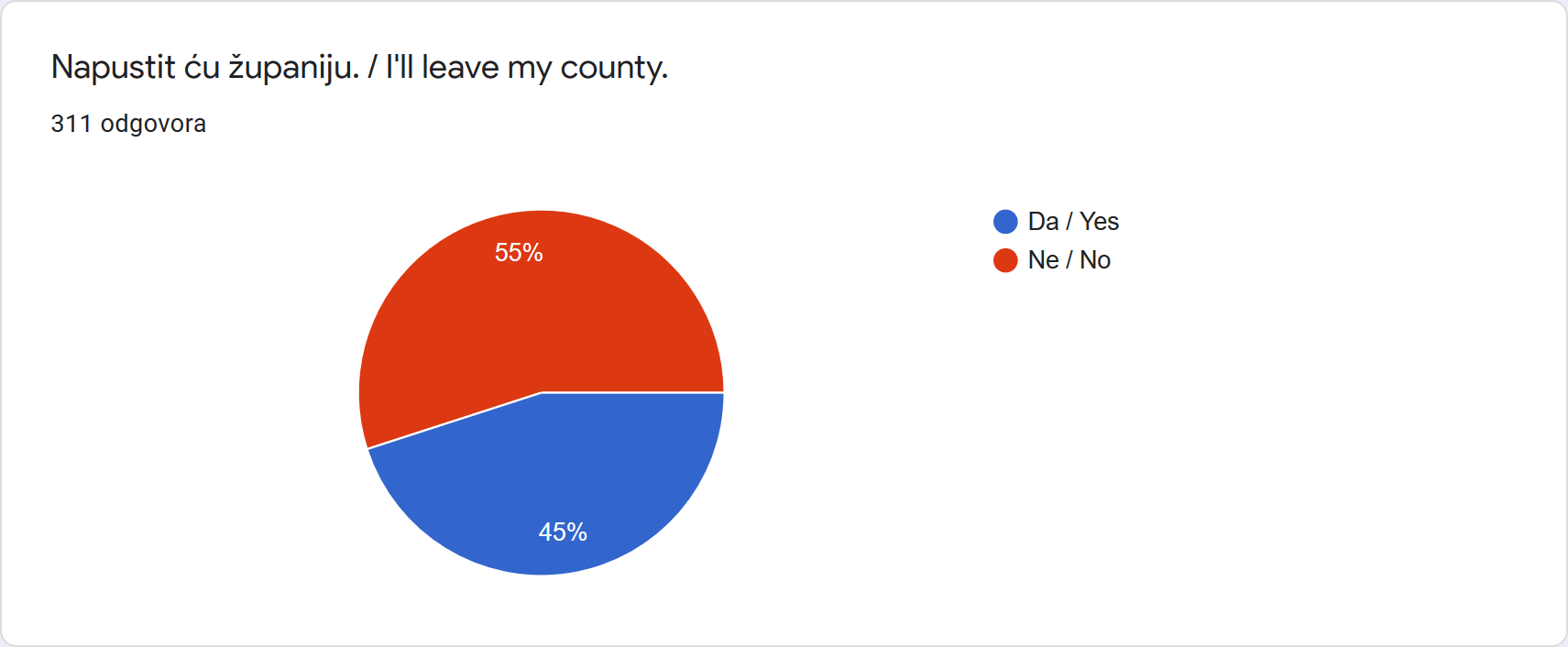
But, when it comes to visiting friends, here, the "yes" answer confidently wins with a total of 71,4%.
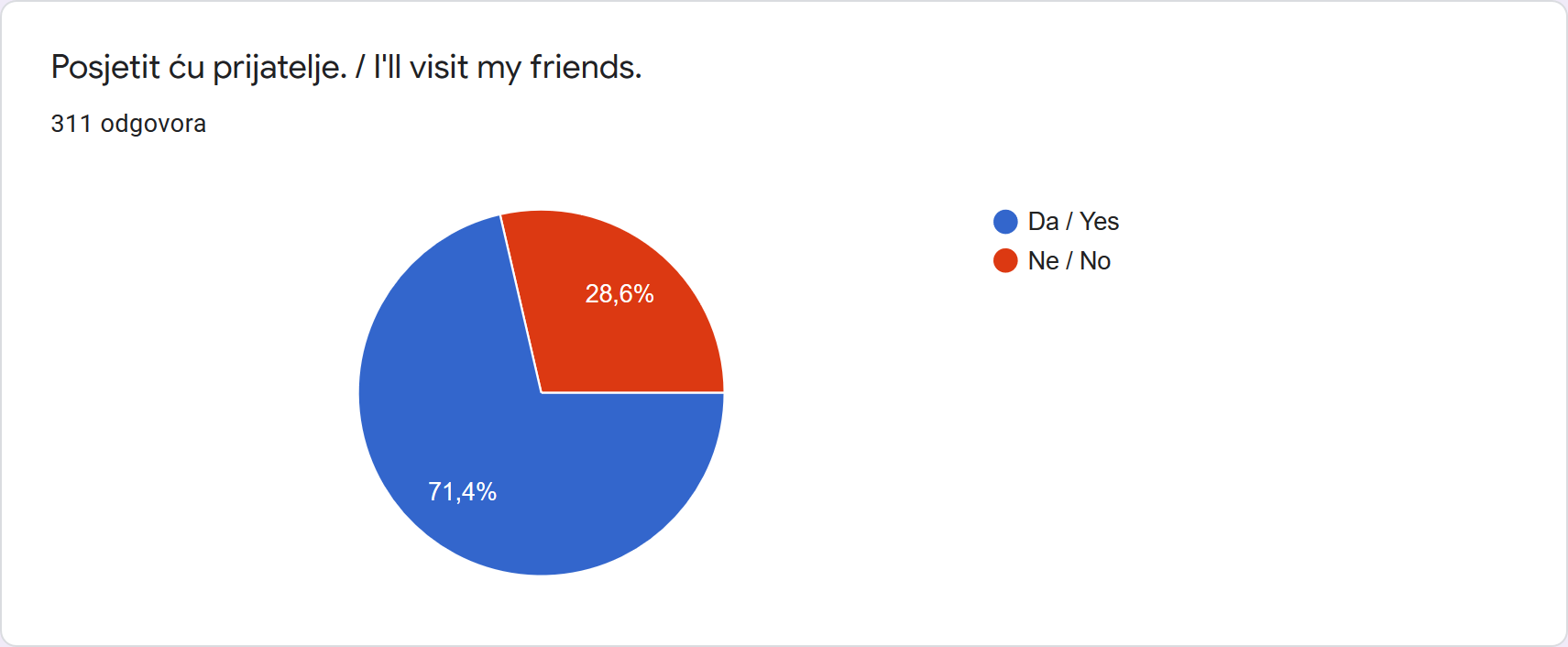
The caution when it comes to shopping is still here - 70,4% of people said they wouldn't go to shopping centers.
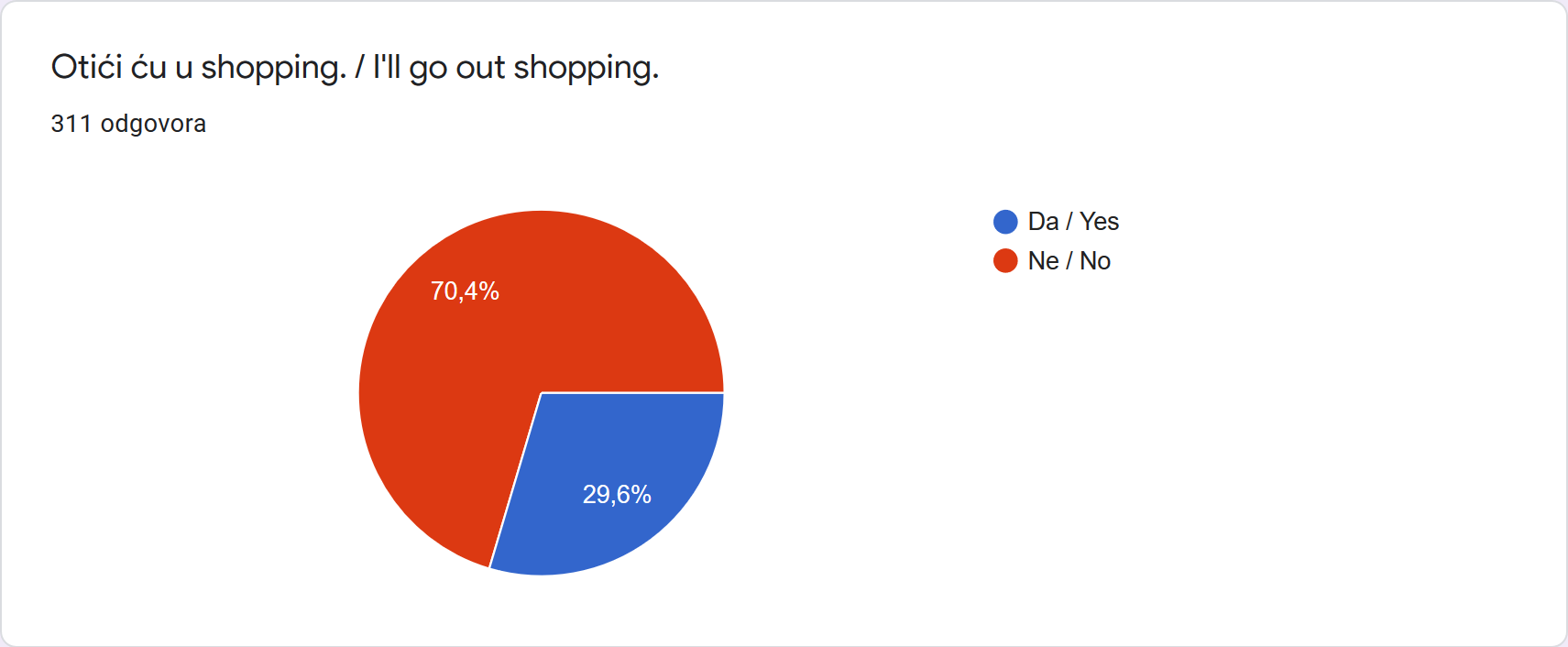
A little less than half of the people answered that they wouldn't stay home, which, after almost two months without that luxury, is understandable.

In the last statement, Croats showed responsibility once more - a total of 82,3% of people steal the show.

A little reminder for everyone: from tomorrow, gatherings of 40 people will be allowed, and e-passes are eliminated. Still, we are called to act responsibly.
Follow our live updates on the coronavirus crisis in Croatia.
Analysis: Coronavirus in Croatia Compared to Other European Countries — April 21 Update
April 22, 2020 — A graph showing the number of deaths from or with the SARS-CoV-2 virus per million population per country places Croatia among the five best-ranked countries with the lowest proportional death toll, according to the Johns Hopkins coronavirus database. In addition to Croatia, there are Greece, Poland, Bulgaria and - according to the available data - Slovakia.
The next group includes the Czech Republic, Hungary, Finland, Romania, Estonia, Norway and Slovenia, with the worst situation affecting Belgium, Spain, Italy and France.
Compared to Croatia, often due to its access to measures to combat the epidemic, Sweden has about 15 times the death toll per million inhabitants.

Specifying only the absolute number infected persons or persons who died from or with the presence of the coronavirus does not give a true picture of the situation. There are huge differences in the population of individual states.
In this way, for example, for a very long time, the terrible situation in Belgium, with its 11.5 million inhabitants in absolute numbers (5,998), had seemingly far fewer casualties than, for example, Italy with its 60,5 million inhabitants (24,648).
It can also be said that Germany with 4,961 deaths has far more casualties than 1,765 in Sweden, which is not really the case. On the contrary, Germany with 83.5 million inhabitants is significantly more successful in fighting the epidemic than Sweden with 10 million inhabitants.
Likewise, it is difficult to compare the development of an epidemic by country in parallel if one looks at the number of confirmed infections persons at the same date, regardless of the outbreak of the epidemic in each country. Instead, we provide an overview for each country that starts on the date the infected person was first registered in that country. In this way, it is possible to compare the development and effects anti-epidemic measures both in dynamics and in relative numbers per million inhabitants.

This chart does not show all the countries that were in the previous one, not only because such a view would become completely opaque, but also because of the abundance of data to be monitored.
At first glance, two groups stand out from the countries observed. The left group is one in which the epidemic developed relatively quickly after the first registered infected person in terms of population: Austria, Norway, Denmark, Sweden, Croatia and Slovakia. Of course, these are smaller countries. The right group is one in which more time has elapsed since the first registration of the infected person, and these are countries with a larger population.
In the first group, there was a rapid increase in the number of people infected in Austria, but also a very rapid response that reversed the epidemic as early as the 32nd day, and even without "leveling”, a consistent reduction in the number of new infections was achieved. The epidemic has calmed down after about 50 days in that country, which of course has a great impact on deciding what to do next.
The epidemic in Norway, with an even sharper start, had a similar course. The rapid reaction of the authorities reversed the trend around the 32nd day as well and achieved a calming epidemic around the 45th day.
In Denmark, the epidemic started very similar to that in Norway, but the epidemic’s spread slowed quickly but soon increased again. Currently, the curve is linear.
The same group is followed by Sweden, which initially did not have rapid growth but, by the 55th day, has grown in the number of registered infected persons and Denmark and Norway, and there is no sign of a slowdown.
Viewed in this chart, Croatia and Slovakia have maintained a very low slope linear curve since the beginning and have the lowest number of registered infected persons per million inhabitants.
The group of larger countries shows the worst situation is in Spain, which after exponential growth until the 56th day of the epidemic in its territory, was able to achieve a linear growth. Then from around the 62nd day, a slightly milder but still large slope with no indication that the epidemic would soon begin to subside.
It is similar in Belgium, which straightened the curve around the 54th day but has since maintained a steady but high (relative) increase in new infections with no indication of calm.
Italy, whose exponential curve started about a week before the one in Spain, reached a more moderate slope of the linear part of the curve around day 49 and shows a slight calming of the epidemic.
Germany, with some time lag compared to the first registered infected person, has achieved a curve similar to Austria, with a change in trend around the 68th day.
After exponential growth, the United Kingdom was able to straighten the curve around day 70, but without a stronger indication of calming.
Let’s look closer to Sweden. We can see a form of exponential growth in the number of infected.

If we take a closer look at Croatia, we will see that linear growth has already been achieved around March 22 (just after the earthquake in Zagreb). An even better curve was achieved after April 1, and that from April 16 it can say it has stifled the epidemic.
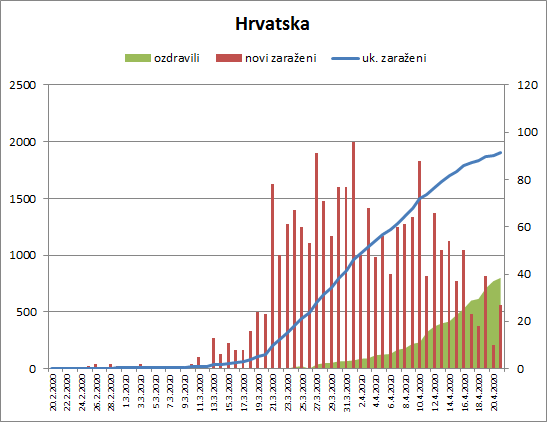
Croatia's excellent result can also be seen in the chart showing the number of patients affected.

These topics often raise the question of what is a good test measure and whether we are testing enough. An excellent graphical representation of the testing ratio per million population and the percentage of positives shows who optimally tests and who does not. If you are about 10% positive you have found a good measure - Croatia is. Something ugly is coming to Brazil, only if the good weather saves them.
 Comparison of the number of tests per million and the percentage of positive ones - by Milan Stevanović 2104
Comparison of the number of tests per million and the percentage of positive ones - by Milan Stevanović 2104
From everything I think it can be concluded how useful it is when policies are established on the basis of scientific knowledge and data. Scientific knowledge, in comparison to the usual political ones, is neither conservative nor radical; they are simply as they are and should be trusted. But these lessons are not exclusively health, but equally political, especially when we talk about loosening up measures.
Of course, any country may be asked what its long-term prospect is in these new circumstances that will not go away. Some countries, which have curbed the epidemic in the sense that they have ensured that their health care system can control the situation, may be far more comfortable developing a further strategy than those who still have to put all their efforts into maintaining the health system's functionality.
And finally - is coronavirus more dangerous than the flu? Yes, but as far as we may know, in just a few months, we learn something new every day. The important difference is that we do not have vaccines and that the virus can mutate more often in a large number of patients.
Krešimir Macan is a public relations professional and political analyst specializing in crisis communications. He has advised two Croatian Prime Ministers, including current Prime Minister Andrej Plenković. He also runs his own PR consultancy, Manjgura.
Krešimir provides TCN with regularly-updated analysis of coronavirus data, helping put Croatia's pandemic response into context.


